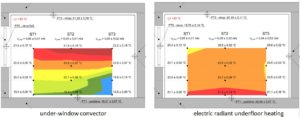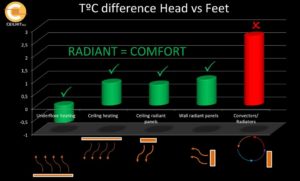Many studies have analysed the thermal comfort within buildings and a lot has been published about the conditions needed to reach such thermal comfort. Actually, the optimum conditions identified include a wide range of ambient temperature (17ºC to 27ºC) and humidity (entre 30 y 70%). And several additional factors have a strong influence, among them, personal factors, metabolic rate, activity level and clothing insulation. In most studies, one of the most relevant cause of thermal discomfort is identified as the “Local Thermal Discomfort” due to an unwanted heating or cooling of one particular part of the body and there are four main causes of this thermal discomfort:
- Air draft
- Vertical air temperature difference (Temperature difference between head and feet)
- Radiant temperature asymmetry
- Contact surface temperature (mainly floor in standard condition).
In regards of all these factors identified, electric radiant heating represents one of the most efficient solutions to contribute to thermal comfort.
In terms of general temperature and humidity conditions, electric radiant heating provides accurate heat deliveries to adjust in each room at any time the temperature to the real needs with fast reaction:
- Independent temperature regulation in each room. Comfort temperatures in a living room, a sleeping room and bathroom are obviously different and should be easily adjusted according to the time of the day, the occupation, the activity, etc…
- Zonal heating and temperature set up in offices. Offices use to be open and wide spaces with very different needs of heat delivery from one part to the other, that can be only fulfilled with radiant heating system. The accuracy of the possible zonal heating with electric radiant heating can be taken down to the level of each work place: The low temperature panels from 100 W to 270 W allow each person to adjust the temperature to its needs at any time.
Moreover, the electric radiant heating systems contributes to reduce the causes of the local thermal discomfort.
- Without air convection: Radiant systems unlike the traditional hot air convection systems (radiators, convectors, forced air systems) don’t use the air convection to transfer the heat inside the room, reducing therefore air drafts.

- Minimum vertical temperature differences: Electric radiant systems don’t generate important temperature stratification inside the room. The study carried out by the UCEEB (University Center for Energy Efficient Buildings) from Polytechnic Prague University clearly evidences the difference between the convection heating systems with high temperature differences depending on the height in the room, versus radiant heating systems with a much more homogeneous profile. Radiant systems provide a temperature difference between head and ankle significantly lower than 1ºC, whereas this difference reaches more than 2.5ºC for hot air convection systems.

- Reduced temperature asymmetry: Surely, underfloor and ceiling heating are the systems that provide the maximum comfort from this point of view. The whole floor (ceiling) surface turns into a very low temperature emitter (temperature similar to people’s average skin temperature), reaching therefore an ideal thermal balance, evenly distributed across the whole room surface. Moreover, electric radiant systems with their high reactivity reach quickly the thermal balance, by transferring the heat directly to the solid bodies (walls, furniture, etc.) and dissipating rapidly any discomfort due to radiant temperature asymmetry.
- Contact with warm surfaces: Finally, electric radiant heating systems heat up quickly the solid bodies within the room (tables, walls, floor) to the comfort temperature, avoiding any discomfort due to contact with cold surfaces. Besides, with underfloor electric heating, the floor is heated up at an average 24 to 27ºC, which has been identified as the ideal floor temperature in terms of people satisfaction.


